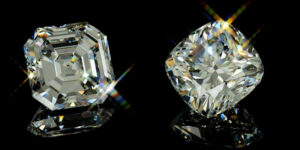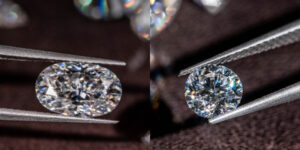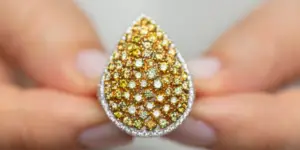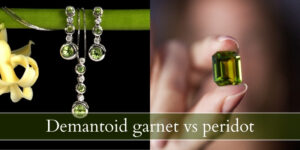Looking for a brilliant cut that’s a bit different from the usual round cut ? Consider the cushion cut, with its rounded square shape and bright sparkle, it’s one of the most popular shapes after rounds and ovals. Take a look at this cushion cut diamond guide so you’re prepared next time you go diamond shopping.
What is a cushion cut diamond ?
Cushion cut diamonds are a type of brilliant cut diamond in a shape resembling a cushion (square with round edges), with plenty of sparkle and a fairly deep cut. Cushion cuts are among the most popular diamond cuts and they also have many variations, in order to get slightly different effects. Most cushion cuts are found in halo settings, and they often have a vintage look to them.
The modern cushion cut is actually inspired by the old mine cut, which is an antique cut that was highly popular in the 18th century. The cushion cut we know today is the old mine cut with a brilliant cut style applied to all the facets. The change came about in the 1900s, after Marcel Tolkovsky invented the round brilliant cut. The cut style was applied to many diamond shapes, including the cushion.
Cushion cuts are a deeper cut, face up smaller
Not all diamonds are cut equally, and some cut shapes and styles result in deeper or shallower diamonds, diamonds that face up larger or smaller, depending on their cut. For example the round brilliant faces up smaller than an oval, since the round carries its weight in the pavilion and the oval in the crown and spread.
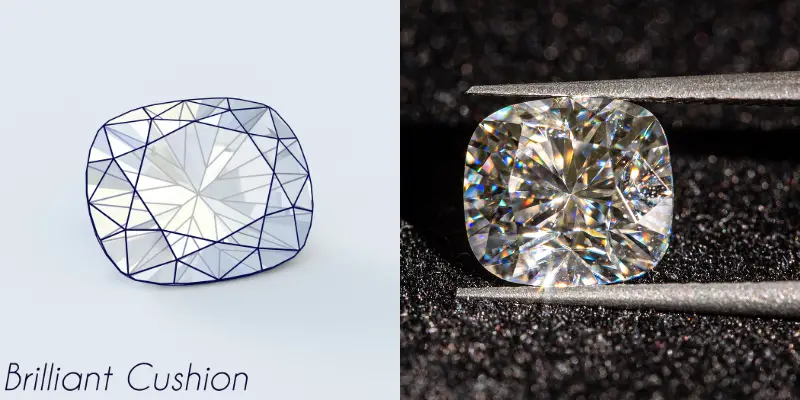
Meanwhile the cushion cut carries most of its weight in the pavilion, just like the round, and it appears smaller than tis carat weight would suggest. This deep cut means even when you set them very low, they will still have a mid to high profile setting. It also means you may want to explore several different cushion cuts until you find the one that looks bright enough, sparkly enough and big enough for what you’re planning.
Cushion cuts look best in a 1:1.10 ratio
Most of the time cushion cuts are squared, and the best length to width ratio for a squared cushion is 1:1.10. Longer cushions may look a bit off, and a cushion that’s 1:1.30 may have a few cut issues since this cut style was not originally intended for an elongated diamond. If you’re looking for an elongated cushion, expect a bowtie effect. This is a dark or dull band along the middle of the diamond where the facets don’t reflect as much light, resulting in a shadow in the shape of a bowtie. Not all bowties are obvious and distracting, you can find a few that are still pleasant to look at.
There are many variations on the cushion cut
The cushion cut is very popular, and it has quite a few variations. The standard cushion cut, or the most common is the brilliant cushion cut. That is the original version and the one you’re most likely to find in a jewelry shop.
The second most popular cushion cut is the crushed ice cushion. This version adds an extra set of facets on the pavilion, further breaking up the reflections within the diamond. This way the sparkles look smaller, like glitter vs sequins. The sparkle is more subdued and there is more brilliance than fire, which may be disappointing for some. Others might enjoy this look more and opt for a crushed ice look.
What is the best color and clarity for cushion cut diamonds ?
Cushion diamonds are a brilliant cut so they hide inclusions and color fairly well. This means you can go as low as an H, possibly an I in color for a brilliant cushion, and VS2 in terms of clarity.
If you’re going for a crushed ice cushion we recommend stopping at an H since there will be more white reflections, and crushed ice cuts tend to concentrate color. So your diamond may appear warmer than you’d like if you go lower than H. Inclusions are still fine, VS2 is still good for a crushed ice cut.
SI1 clarity might also work in cushion cuts, but you need an eye clean one. A diamond where the inclusion is not under the table the crown, or near the edges. Try to look for one with the inclusion towards the pavilion or culet, since it will be more easily reflected and hidden if it’s there.
Read also: Radiant Cut Diamond Guide
Do cushion cuts sparkle ?
Yes, and they have more fire than brilliance. This is the result of cushion cuts being heavily inspired by the old mine cut, which was made specifically for rainbow sparkles, and not for brightness or brilliance. The cushion cut has smaller facets than the old mine cut but the extra fire is still there, at last in brilliant cushions.
In crushed ice cushions you can expect less fire than usual, and more brilliance. The diamond will still sparkle, but less so than the brilliant version.
What’s the best setting for a cushion cut ?
Cushion cuts, like all brilliant cuts, look best in a prong setting which allows the most light into the diamond. But most often you’ll see the cushion surrounded by a halo of smaller diamonds, usually to made the diamond look a bit larger.
Since cushion cuts are fairly deep cuts, they would work best in a cathedral setting. This way the shoulders leading from the diamond would add more security than a dainty prong or Tiffany setting. Couple this with a halo setting and you’ve got one of the most popular yet safe engagement ring settings on the market.
Are cushion cut diamonds expensive ?
Cushion cut diamonds are usually around $4,200 per carat for an H color and VS2 clarity. For comparison a round brilliant with the same stats runs for about $8,000 and an oval for $4,900. So cushions aren’t the most expensive diamond cuts you can find, but of course the higher you go in clarity and color, the higher the price tag, usually for roughly $800 extra for each grade up.
Does this make a cushion cut engagement ring cheap or tacky ? No way, these diamonds are beautiful and sparkle like mad. One of the key reasons they’re so affordable is that they retain a lot of the original rough diamond, so not much goes to waste.

I’m the main author for jewelrymaterialguide.com. I started this site after we did tons of research before our wedding and noticed that there is information about rings, jewelry, and so on that is really hard to find on the internet.


